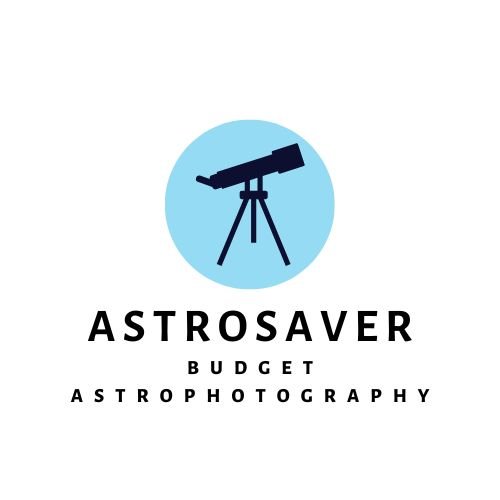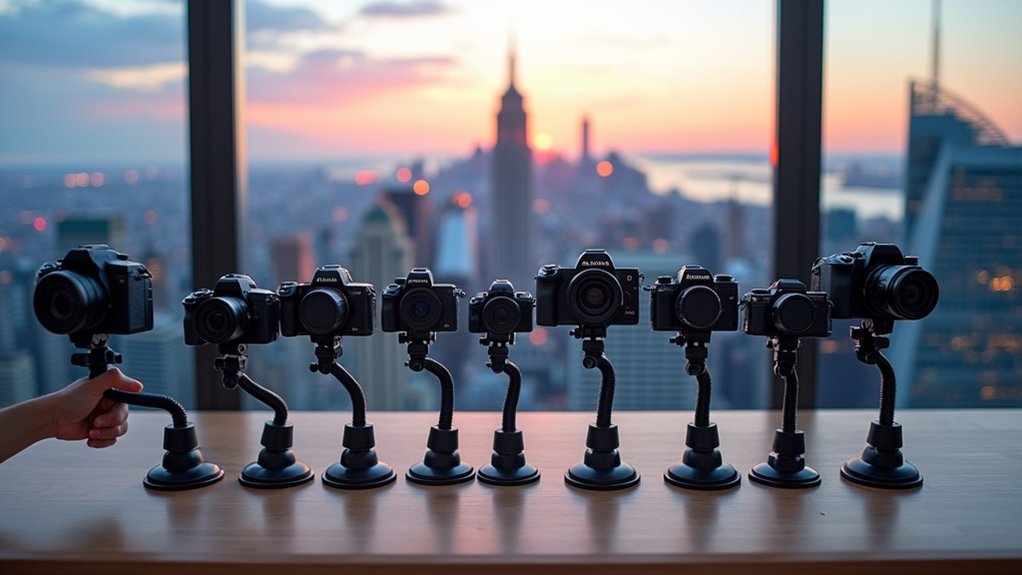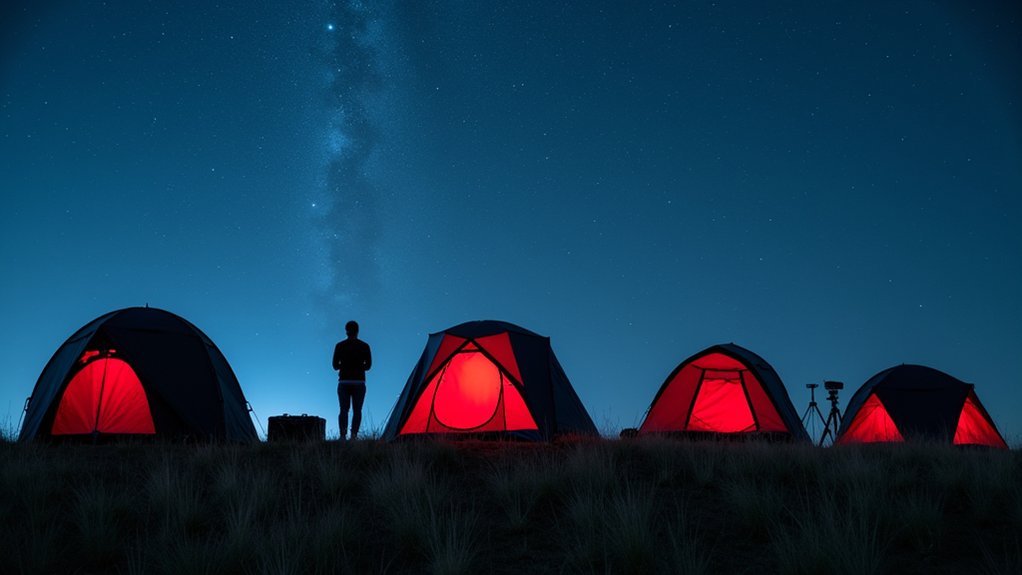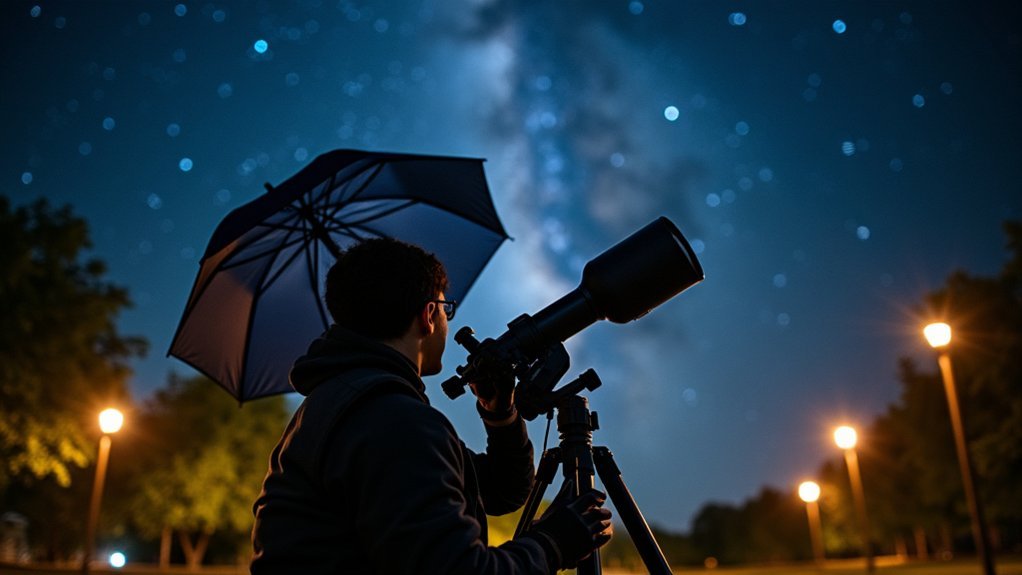For urban stargazing, start with a broadband filter like the Optolong L-Pro or SVBONY SV220 to reduce light pollution while maintaining versatility. If you're primarily interested in viewing nebulae, consider a UHC filter like Sky-Watcher's for enhanced contrast. Install between your eyepiece and telescope, and expect better results on emission nebulae than galaxies. Choose 2-inch filters for larger telescopes or clip-in versions for DSLRs. The right filter can transform your celestial viewing experience.
Understanding Light Pollution's Impact on Stargazing

While astronomy enthusiasts yearn for crystal-clear night skies, the reality is that light pollution increasingly hampers our view of the cosmos. Over 80% of the world's population lives under light-polluted skies, with conditions deteriorating rapidly.
You'll encounter four types of light pollution: skyglow (the hazy glow above cities), glare, light trespass, and clutter. These don't just affect your stargazing—they disrupt entire ecosystems by interfering with natural biological rhythms.
Modern LED lighting compounds the problem with excessive blue light emission, making telescope observations particularly difficult. The alarming increase of nearly 10% annually in light pollution is much higher than researchers previously thought.
The harsh blue glow of LEDs bombards our night sky, turning telescope viewing into an increasingly futile pursuit.
Even if you find a remote viewing location, you'll likely face increasing light pollution and satellite interference. Starlink and other satellite constellations create trails that contaminate astronomical images, further complicating your ability to capture the night sky's wonders.
The Basic Science Behind Light Pollution Filters
At the core of every light pollution filter lies a sophisticated mechanism that selectively blocks unwanted wavelengths from artificial light sources.
These filters work by suppressing specific light wavelengths that come from streetlights and other human-made sources, while allowing the light from celestial objects to pass through to your eye.
- Selective Wavelength Blocking – Filters are particularly effective against traditional sodium and mercury vapor lights but struggle with modern LED lighting. Mercury-vapor lamps emit light at specific wavelengths including 405nm and 546nm, which quality filters can effectively block.
- Enhanced Contrast – By darkening the background sky, filters make nebulae and other faint objects more visible.
- Specialized Designs – Broadband filters transmit a wide range of wavelengths, while narrowband filters isolate specific emissions.
- Material Technology – Modern manufacturing techniques create affordable filters that fit standard telescope eyepieces.
Broadband vs. Narrowband: Which Is Right for Beginners?

For amateur stargazers steering their first telescope purchase, the choice between broadband and narrowband filters represents a significant decision.
Broadband filters offer greater versatility and accessibility for newcomers, working well across various celestial objects while managing light pollution at a reasonable price. Users often report little noticeable difference with broadband filters compared to narrowband options, especially in heavily light-polluted areas.
While narrowband filters excel at capturing stunning nebulae details, particularly in light-polluted areas, they require longer exposure times and more technical knowledge. They're also optimized for monochrome cameras and demand advanced post-processing skills.
If you're just starting out, you'll likely benefit from a broadband filter's user-friendly nature and broader application.
Save narrowband options for when you've developed specific interests in nebulae photography and gained more experience with astrophotography techniques and equipment.
Top Budget-Friendly Filters for Urban Astronomers
Urban sky conditions don't have to limit your astronomy passion when you've got the right budget-friendly filters.
You'll find options like the Optolong L-Pro and SVBONY SV220 that effectively reduce light pollution without emptying your wallet.
These affordable filters can transform your city stargazing experience, revealing celestial details that would otherwise remain hidden behind the urban glow. Understanding your local light pollution levels using the Bortle Scale can help you select the most effective filter for your specific urban environment.
City Skies, Clear Views
While light pollution presents a significant challenge to urban stargazers, budget-friendly filters can dramatically improve your viewing experience without breaking the bank.
The Sky-Watcher UHC and SVBONY SV220 provide exceptional value for beginners, effectively reducing light pollution from mercury and sodium vapor streetlights common in urban environments.
- Sky-Watcher UHC – Offers excellent contrast enhancement at an affordable price point, ideal for nebulae observation. Sky-Watcher UHC produces a good dark background while allowing even faint features like M43 in the Orion Nebula to be visible.
- SVBONY SV220 – Cost-effective option specifically designed for astrophotography applications.
- Baader UHC-S – Mid-range filter balancing performance and cost for visual observers.
- Orion UltraBlock – Narrowband option that excels in heavily light-polluted city conditions by focusing on specific wavelengths.
Affordable Filter Showdown
When stepping into astronomy with a limited budget, you'll find several excellent light pollution filters that deliver impressive performance without the premium price tag.
The NEEWER Natural Night Filter offers durability with its scratch-resistant, waterproof coating—perfect for beginners. For deep-sky imaging, consider the cost-effective SVBONY SV220, which excels at capturing h-alpha emissions.
The Sky-Watcher UHC creates impressive dark backgrounds that make nebulae pop, while Burgess Optical's Broadband Nebula Filter provides affordable views of objects like the Orion Nebula.
Most budget options work well in urban areas and backyard setups. You'll appreciate how these filters enhance contrast by blocking unwanted wavelengths, making celestial objects more visible even from light-polluted locations. Remember that effectiveness tends to diminish in heavily polluted areas where light pollution is extreme.
They're easy to install and versatile enough for both visual observation and photography.
How to Match Filters to Your Viewing Location

Selecting the right light pollution filter depends largely on your specific viewing conditions and location type. The severity of light pollution in your area directly impacts which filter will provide the best results for your stargazing sessions.
Your filter choice must align with your viewing location—urban, suburban, or rural environments each demand different filtration solutions.
- Urban Settings – In heavily light-polluted cities, narrowband filters are your best option as broadband filters become less effective. Focus on filters specifically designed for high light pollution environments. Specialized options like the Vespera filter are designed to block Na and Hg wavelengths commonly emitted by urban lighting.
- Suburban Areas – Broadband filters work well here, offering noticeable improvement in contrast for deep-sky objects without sacrificing too much brightness.
- Rural Locations – You'll need minimal filtration, though broadband filters can still enhance contrast for certain objects. Consider if you need a filter at all.
- Mixed Viewing Sites – If you observe from various locations, invest in a versatile filter that performs reasonably well across different light pollution levels.
Essential Filters for Viewing Nebulae From the City
In city environments, you'll need to choose between narrowband filters for isolating specific emission wavelengths and broadband filters for general light pollution reduction.
Narrowband options like OIII and H-beta filters offer superior performance for emission nebulae under heavy light pollution, while UHC filters provide a versatile middle ground. Proper dark adaptation significantly enhances the effectiveness of these filters when observing from urban locations.
For astronomers on a budget, entry-level UHC filters from brands like Sky-Watcher or Orion can dramatically improve your nebula views without breaking the bank.
Narrowband vs. Broadband Choices
The battle between urban light pollution and a stargazer's quest to observe nebulae can be won with the right filter selection. When choosing between narrowband and broadband filters, consider your viewing location and targets.
- Narrowband filters excel in urban environments by isolating specific wavelengths (H-alpha, OIII, H-beta), dramatically improving emission nebulae visibility even in heavily light-polluted skies.
- Broadband filters work best in suburban areas where light pollution is moderate, allowing you to observe a wider variety of objects including galaxies and star clusters.
- Contrast enhancement is stronger with narrowband filters for emission nebulae, while broadband options preserve more natural colors and brightness. For serious nebula observers, filters with lower FWHM values provide superior isolation of emission lines and clearer images.
- Target specificity matters—narrowband for emission nebulae and planetary nebulae; broadband for galaxies and reflection nebulae.
Budget-Friendly Filter Options
While specialized narrowband and broadband filters deliver impressive performance, you don't need to empty your wallet to experience improved celestial views from light-polluted areas.
The Hoya Red Intensifier offers an affordable entry point that effectively filters out yellow-orange light pollution from sodium vapor lamps, enhancing contrast for many deep-sky objects.
The SVBONY SV220 provides excellent value for budget-conscious astrophotographers, delivering good performance across various targets.
When selecting a budget filter, consider your local light pollution type and primary observing targets.
While these economical options won't match premium filters' capabilities, they'll still dramatically improve your urban stargazing experience.
Good quality filters typically cost around 150 dollars, which may exceed many beginners' budgets, making these more affordable alternatives particularly valuable.
Getting Started With the Sky-Watcher UHC Filter

Choosing a Sky-Watcher UHC filter represents an excellent first step for stargazers looking to enhance their views of emission nebulae in light-polluted environments. This filter dramatically improves contrast by passing only specific wavelengths while blocking unwanted light pollution.
To get the most from your UHC filter:
- Thread it directly onto your 1.25" or 2" eyepieces for easy installation.
- Target emission nebulae like Orion, Swan, and Lagoon for the most dramatic improvements.
- Shield your eyes from stray light to maintain dark adaptation while observing.
- Don't use it for galaxies or star clusters as it will make these objects too dim.
Unlike broadband filters, the UHC's narrower bandpass makes it effective in both urban and rural settings, particularly with smaller aperture telescopes. The filter specifically allows doubly ionized oxygen and hydrogen-beta wavelengths to pass through while blocking everything else.
Optolong L-Pro: A Beginner's First Astrophotography Filter
The Optolong L-Pro filter offers exceptional light transmission across the 380-750nm range while blocking common artificial light pollution sources like mercury and sodium vapor lamps.
You'll find its $149 starting price for the 1.25" version delivers remarkable value considering its ability to enhance nebulae and galaxy details in both visual and photographic applications.
Setting up the L-Pro couldn't be simpler—just thread it onto your telescope's eyepiece or camera adapter, and you're ready to enjoy improved contrast and color balance without greatly increasing exposure times. The filter is particularly effective for capturing reflection nebulae and globular star clusters even in areas with significant light pollution.
Light Transmission Benefits
For beginner astrophotographers struggling with light pollution, Optolong L-Pro filters offer significant advantages through their selective light transmission properties.
They're designed to block unwanted artificial light while preserving the important wavelengths of deep sky objects.
- Enhanced contrast – These filters block major light pollution wavelengths (mercury and sodium vapor lights) without brightening the object itself.
- Preserved nebula emissions – High transmission of key emission lines (H-alpha, OIII, SII) guarantees your targets remain visible.
- Built-in IR protection – Blocks infrared wavelengths, eliminating the need for a separate IR-cut filter.
- Natural color balance – Multi-bandpass design maintains more realistic coloration in your images than single-bandpass filters.
The high-quality Schott B270 glass substrate ensures optical precision while maintaining durability for long-term use.
You'll enjoy longer possible exposures in urban environments while maintaining good color balance for galaxies and star clusters.
Price-to-Performance Ratio
When evaluating your first serious astrophotography filter, the Optolong L-Pro stands out as an exceptional value proposition in the moderately-priced segment.
You'll find it strikes an impressive balance between cost and effectiveness compared to both budget options and premium alternatives like Astronomik or IDAS filters.
The L-Pro's high-quality optical coatings and construction deliver tangible improvements to your images without breaking the bank. Its broadband filtering effectively blocks common light pollution sources while maintaining natural color balance in your photographs. Remember to use the coupon code "WorkshopStudent" for an additional 5% discount on your purchase.
This versatility makes it suitable for both visual observation and imaging applications.
The 2mm filter thickness and ultra-thin cell design minimize vignetting issues, while the quality Schott glass substrate ensures optical clarity and durability—features you'd typically expect in more expensive filters.
Setup and Usage
Setting up your Optolong L-Pro filter requires minimal technical expertise, making it an ideal starting point for astronomy enthusiasts venturing into astrophotography.
The filter's versatile M48 threaded cell allows for seamless integration with most telescope setups, while clip-in versions accommodate popular DSLR cameras from Canon and Nikon.
To maximize your stargazing experience:
- Choose the right size – Select 2-inch filters for telescopes with large eyepieces or the appropriate clip-in version for your camera model.
- Install with care – Thread the filter between your telescope and camera or clip it directly into your DSLR body.
- Store properly – Use the included protective case when not in use to prevent scratches.
- Start with familiar targets – Galaxies and reflection nebulae will show immediate contrast improvement.
Our experts with 117 years total combined astronomy experience recommend this filter as an excellent first purchase for combating urban light pollution.
When to Use Filters (And When to Skip Them)
Choosing the right moment to deploy light pollution filters can dramatically transform your stargazing experience. Use them when observing nebulae or deep-sky objects in moderately light-polluted areas, where they'll enhance contrast and improve background darkness.
You'll want to skip filters when viewing bright objects like the Moon and planets, as they're unnecessary and may diminish visibility. Similarly, if you're observing from pristine dark skies, filters won't provide significant benefits.
They're also less effective in extremely light-polluted urban environments. Consider your specific target—broadband filters work well for galaxies and general deep-sky viewing, while narrowband and OIII filters excel with nebulae. When selecting filters, consider which mounting options are compatible with your current telescope setup and potential future equipment.
Remember that frequent object switching might make filter changes cumbersome, so plan your observing session accordingly.
Setting Realistic Expectations for Filter Performance

While knowing when to use filters is important, understanding what they can realistically accomplish will prevent disappointment at the eyepiece.
Even premium filters won't transform a light-polluted suburban sky into a pristine dark site experience.
- Urban Performance – Filters improve contrast but won't eliminate all light pollution; heavily light-polluted areas will still limit what you can see. The most effective filters block specific wavelengths from streetlights while allowing celestial light to pass through unhindered.
- Target Specificity – Some objects like galaxies show minimal improvement with filters while emission nebulae respond dramatically.
- Equipment Interaction – Your telescope's focal ratio affects filter performance; slower f/ratios typically work better with narrowband filters.
- Budget Considerations – While high-end filters offer superior results, mid-range options can provide satisfactory performance for beginners without breaking the bank.
Pairing Your Filter With the Right Telescope
The effectiveness of any light pollution filter depends largely on how well it's matched to your specific telescope setup.
For reflectors, consider clip-in filters that guarantee complete sensor coverage. Refractors work best with 2-inch or 1.25-inch threaded filters that install easily in the optical path.
Your telescope's speed matters too—fast optics like RASA or Hyperstar systems need specialized filters designed for low focal ratios. The Celestron Light Pollution Imaging Filter ensures over 90% transmission while maintaining neutral color balance for deep-sky objects. Schmidt-Cassegrain owners should look for compatible adapters to optimize performance.
Choose filter size based on your imaging equipment: 2-inch filters cover full-frame cameras completely, while 1.25-inch options suit smaller sensors and telescopes.
If you're using a DSLR or mirrorless camera, clip-in filters provide versatility across different lenses. Remember that M48 threaded filters offer broad compatibility with various telescope accessories.
First Night Out: Tips for Using Your New Filter
Your first night using a light pollution filter can make or break your stargazing experience. Proper setup and realistic expectations will help you make the most of your investment. Before heading out, verify your filter is securely attached to your eyepiece or camera lens.
- Start with bright, familiar objects to notice the filter's effect before moving to dimmer deep-sky targets.
- Take time to refocus your telescope after installing the filter, as it might slightly affect your focusing point.
- Compare views with and without the filter to appreciate the contrast improvement.
- Store your filter in its protective case when not in use to prevent damage or fingerprints.
Consider filters like the Optolong L-Quad Enhance Filter which offers quad bandpass technology for superior nebula and galaxy viewing in light-polluted areas.
Remember that different objects respond differently to various filter types, so be patient as you explore the night sky.
Upgrading Your Filter Collection as Skills Improve
As your stargazing skills develop, upgrading your filter collection becomes a natural evolution in your astronomical journey. Start by investing in quality broadband filters, which enhance contrast for a variety of deep-sky objects while blocking sodium and mercury lamp light pollution.
Enhance your celestial views by gradually building a quality filter collection matched to your observing conditions.
When you're ready to advance, consider moving to narrowband filters that isolate specific wavelengths like H-alpha and OIII. These are particularly effective for emission nebulae and provide dramatic visual improvements when you're properly dark-adapted. Spending 15-20 minutes in complete darkness before viewing will maximize the effectiveness of your filters.
Your upgrade path should match both your observing conditions and preferred targets. In urban areas, specialized narrowband filters often outperform broadband options.
Remember that filter size matters too—ensure compatibility with your eyepieces (1.25" or 2"). The most sophisticated filters feature multi-layer coatings that greatly reduce light pollution effects.
Frequently Asked Questions
Can Light Pollution Filters Be Stacked for Better Results?
No, you shouldn't stack light pollution filters. Doing so typically increases unwanted reflections, reduces light transmission, and creates mechanical issues. In selective cases where filters don't overlap spectrally, it might work, but it's generally discouraged.
Do Filters Require Different Eyepieces Than Standard Viewing?
No, you don't need special eyepieces for light pollution filters. They're designed to screw directly into standard 1.25" or 2" eyepieces using compatible threads, making them easy to swap between your existing equipment.
How Often Should Light Pollution Filters Be Cleaned?
You should clean your light pollution filters after each significant use or dust exposure. Use a microfiber cloth for routine cleaning, and always handle by edges to avoid fingerprints. Regular maintenance preserves optical clarity.
Will Filters Affect the Color Accuracy of Planets?
Yes, light pollution filters will affect your planetary color accuracy. They're designed for deep-sky objects, not planets. If you're focusing on planetary observation, you'll want specialized planetary filters instead for true colors.
Can Filters Damage Telescope Sensors or Camera Equipment?
No, quality light pollution filters won't damage your equipment. They're designed to block specific wavelengths, not harm sensors. Just confirm proper fitting and regular cleaning to avoid optical issues from dust or moisture.
In Summary
You've now got the knowledge to choose your first light pollution filter wisely. Start with a quality broadband filter that matches your viewing conditions and telescope. Don't expect miracles—filters enhance, not transform. As you're growing in experience, you'll naturally identify which specialized filters suit your observing preferences. The right filter will help you see deeper into the cosmos, even from light-polluted skies.





Leave a Reply